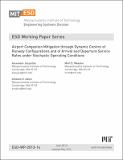| dc.description.abstract | The high levels of flight delays require the implementation of airport congestion mitigation tools. In this paper, we optimize the utilization of airport capacity at the tactical level in the face of operational uncertainty. We formulate an original Dynamic Programming model that selects jointly and dynamically runway configurations and the balance of arrival and departure service rates at a busy airport to minimize congestion costs, under stochastic queue dynamics and stochastic operating conditions. The control is exercised as a function of flight schedules, of arrival and departure queue lengths and of weather and wind conditions. We implement the model in a realistic setting at JFK Airport. The exact Dynamic Programming algorithm terminates within reasonable time frames. In addition, we implement an approximate one-step look-ahead algorithm that considerably accelerates the execution of the model and results in close-to-optimal policies. In combination, these solution algorithms enable the on-line implementation of the model using real-time information on flight schedules and meteorological conditions. The application of the model shows that the optimal policy is path-dependent, i.e., it depends on prior decisions and on the stochastic evolution of arrival and departure queues during the day. This underscores the theoretical and practical need for integrating operating stochasticity into the decision-making framework. From comparisons with an alternative model based on deterministic queue dynamics, we estimate the benefit of considering queue stochasticity at 5% to 20%. Finally, comparisons with advanced heuristics aimed to imitate actual operating procedures suggest that the model can yield significant cost savings, estimated at 20% to 30%. | en_US |
